
Bellona is a large main-belt asteroid. It was discovered by German astronomer R. Luther on March 1, 1854, and named after Bellōna, the Roman goddess of war; the name was chosen to mark the beginning of the Crimean War. It is a stony (S-type) asteroid with a cross-section size of around 100–120 km. 28 Bellona is orbiting the Sun with a period of 4.63 years.

Laetitia is a large main-belt asteroid that was discovered by French astronomer Jean Chacornac on 9 February 1856 and named after Laetitia, a minor Roman goddess of gaiety. The spectrum matches an S-type, indicating a stony (silicate) composition. It is orbiting the Sun with a period of 4.61 years and is spinning on its axis once every 5.1 hours.

Leto is a large main belt asteroid that is orbiting the Sun. The asteroid was discovered by German astronomer Robert Luther on April 29, 1861, and is named after Leto, the mother of Apollo and Artemis in Greek mythology. It is orbiting at a distance of 2.78112 AU with a period of 4.64 years and an orbital eccentricity of 0.187. The orbital plane is inclined at an angle of 7.97° to the ecliptic.
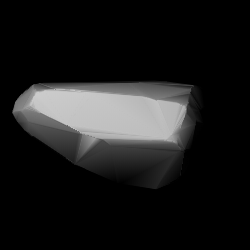
Austria is a main-belt asteroid that was found by the prolific asteroid discoverer Johann Palisa on 18 March 1874, from the Austrian Naval Observatory in Pola, Istria. It was his first asteroid discovery and was given the Latin name of his homeland.
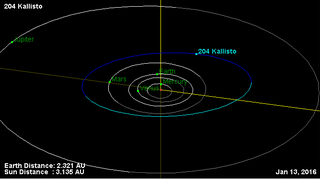
Kallisto is a fairly typical, although sizeable Main belt asteroid. It is classified as an S-type asteroid. Like other asteroids of its type, it is light in colour. It was discovered by Johann Palisa on 8 October 1879, in Pola, and was named after the same nymph Callisto in Greek mythology as Jupiter's moon Callisto.
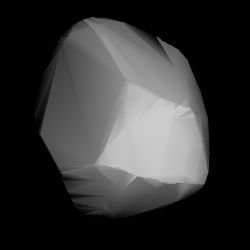
Eudora is a large Main belt asteroid. It was discovered by French (Corsican) astronomer J. Coggia on August 30, 1880, in Marseilles, France. It was his fourth asteroid discovery and is named after Eudora, a Hyad in Greek mythology.

Carolina is a sizeable Main belt asteroid. It was discovered by Austrian astronomer Johann Palisa on 28 November 1883 in Vienna, and was named after Caroline Island, now part of Kiribati in the Pacific Ocean. This asteroid is orbiting the Sun at a distance of 2.88 AU with a period of 4.89 yr and an eccentricity (ovalness) of 0.06. The orbital plane is tilted at an angle of 9.0° to the plane of the ecliptic.
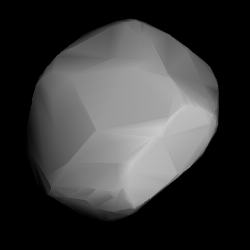
Hypatia is a very large main-belt asteroid that was discovered by Russian astronomer Viktor Knorre on July 1, 1884, in Berlin. It was the third of his four asteroid discoveries. The name was given in honour of philosopher Hypatia of Alexandria. Based upon the spectrum, it is classified as a C-type asteroid and is probably composed of primitive carbonaceous material. Like many asteroids of this type, its surface is very dark in colour.

Vanadis is a fairly large main-belt asteroid with a diameter of around 100 km. It was discovered by A. Borrelly on August 27, 1884, in Marseilles and was named after Freyja (Vanadis), the Norse fertility goddess. The asteroid is orbiting the Sun at a distance of 2.67 AU with a period of 4.35 yr and an orbital eccentricity of 0.206. The orbital plane is inclined at an angle of 2.10° to the plane of the ecliptic.

Florentina is an S-type (stony) main belt asteroid with a diameter of 28 km. It was discovered by Johann Palisa on 15 October 1891 in Vienna. He named the asteroid for his daughter, Florentine. Between 1874 and 1923, Palisa discovered a total of 122 asteroids.
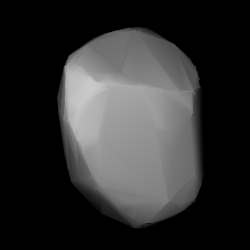
Gudrun is a main-belt asteroid.

Etheridgea is a large main belt asteroid. It was discovered by Auguste Charlois on 1 April 1892 in Nice. The meaning of the name is unknown. This asteroid is orbiting the Sun at a distance of 3.02 AU with a period of 5.26 years and an eccentricity (ovalness) of 0.10. The orbital plane is tilted at an angle of 6.05° to the plane of the ecliptic.

May is a large Main belt asteroid. It was discovered by Auguste Charlois on 28 November 1892 in Nice, and was named for the German author Karl May. This asteroid is orbiting the Sun at a distance of 2.97 AU with a period of 5.12 years and an eccentricity (ovalness) of 0.067. The orbital plane is inclined at an angle of 9.7° to the plane of the ecliptic. During its orbit, this asteroid has made close approaches to the dwarf planet Ceres. For example, in September 1984 the two were separated by 6.3 Gm (0.042 AU).

402 Chloë is a large main-belt asteroid. It was discovered by French astronomer Auguste Charlois on 21 March 1895 from Nice. This asteroid is orbiting the Sun at a distance of 2.56 AU with a period of 4.09 years and an eccentricity of 0.11. The orbital plane is inclined at an angle of 11.8° to the plane of the ecliptic.
Stereoskopia is a large, outer main-belt asteroid orbiting the Sun. It was discovered on 28 May 1905 from Heidelberg by German astronomer Paul Götz. The discovery was made from photographic plates with the use of a stereo-comparator that had been provided by Carl Pulfrich, a German physicist at the Carl Zeiss Company. The asteroid name is a reference to this device.
741 Botolphia is a 29.6-km diameter minor planet orbiting in the asteroid belt, discovered by American astronomer Joel Hastings Metcalf on 10 February 1913 from Winchester. It is named after Saint Botolph, the semi-legendary founder of a 7th-century monastery that would become the town of Boston, Lincolnshire, England. This asteroid is orbiting at a distance of 2.72 AU from the Sun, with an orbital period of 4.49 yr and an eccentricity (ovalness) of 0.07. The orbital plane is inclined at an angle of 8.41° to the ecliptic.
774 Armor is a minor planet orbiting in the main belt. It was discovered on December 13, 1913, in Paris by French astronomer Charles le Morvan and was named after the Celtic region of Armorica. The asteroid is orbiting at a distance of 3.05 AU with a period of 5.32 yr and an eccentricity of 0.169. The orbital plane is inclined by an angle of 5.56° to the plane of the ecliptic.
790 Pretoria is a minor planet orbiting the Sun that was discovered by English astronomer Harry Edwin Wood on January 16, 1912. It is a member of the Cybele group located beyond the core of the main belt and named after Pretoria, the capital city of South Africa.
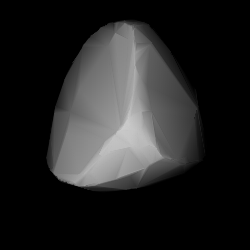
1328 Devota, provisional designation 1925 UA, is a dark background asteroid from the outermost regions of the asteroid belt, approximately 56 kilometers in diameter. It was discovered on 21 October 1925, by Russian–French astronomer Benjamin Jekhowsky at the Algiers Observatory in North Africa. The asteroid was named after Argentine astronomer Fortunato Devoto.
(457175) 2008 GO98, provisional designation 2008 GO98 with cometary number 362P, is a Jupiter family comet in a quasi-Hilda orbit within the outermost regions of the asteroid belt. It was discovered on 8 April 2008, by astronomers of the Spacewatch program at Kitt Peak National Observatory near Tucson, Arizona, in the United States. This presumably carbonaceous body has a diameter of approximately 15 kilometers (9 miles) and rotation period of 10.7 hours.















